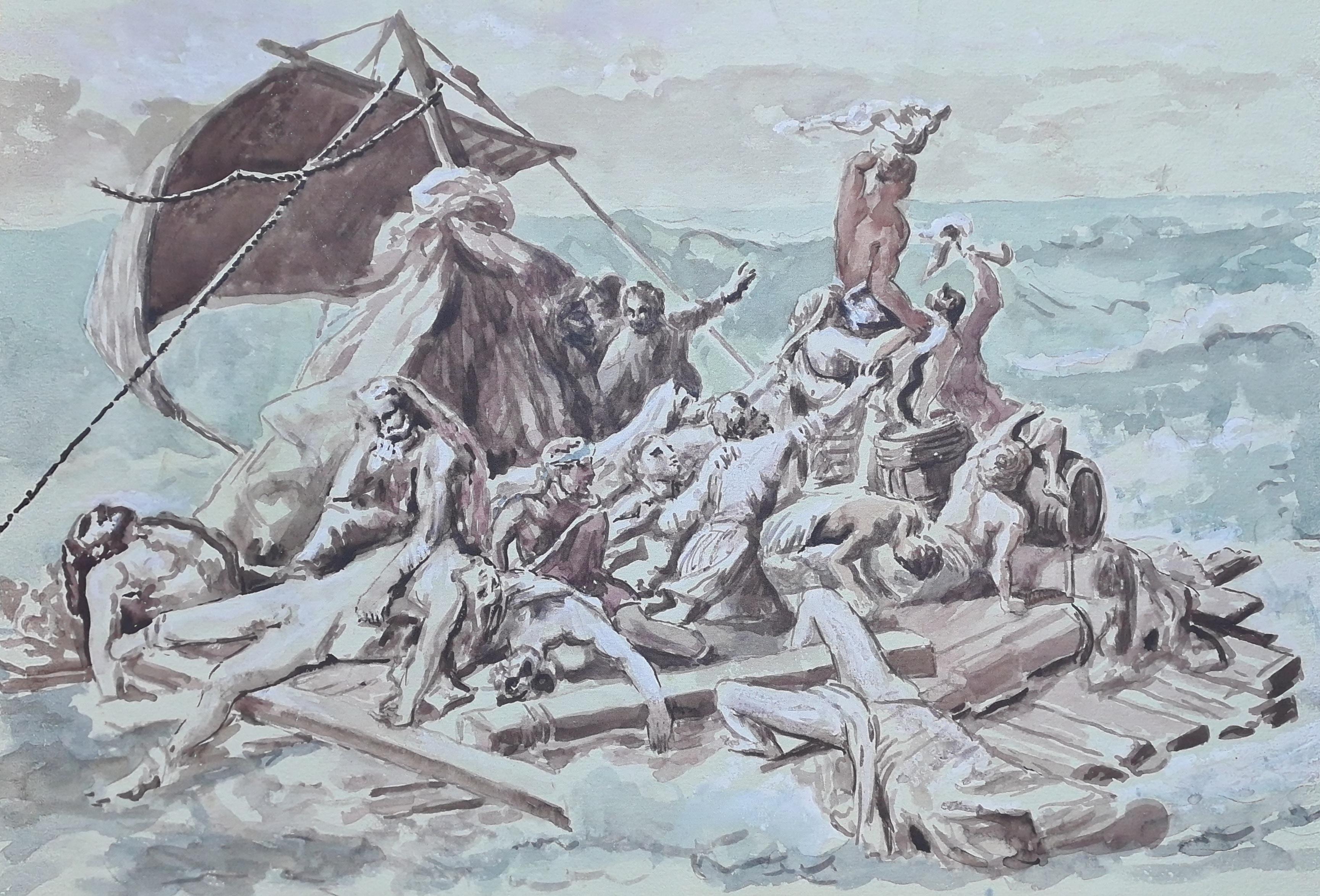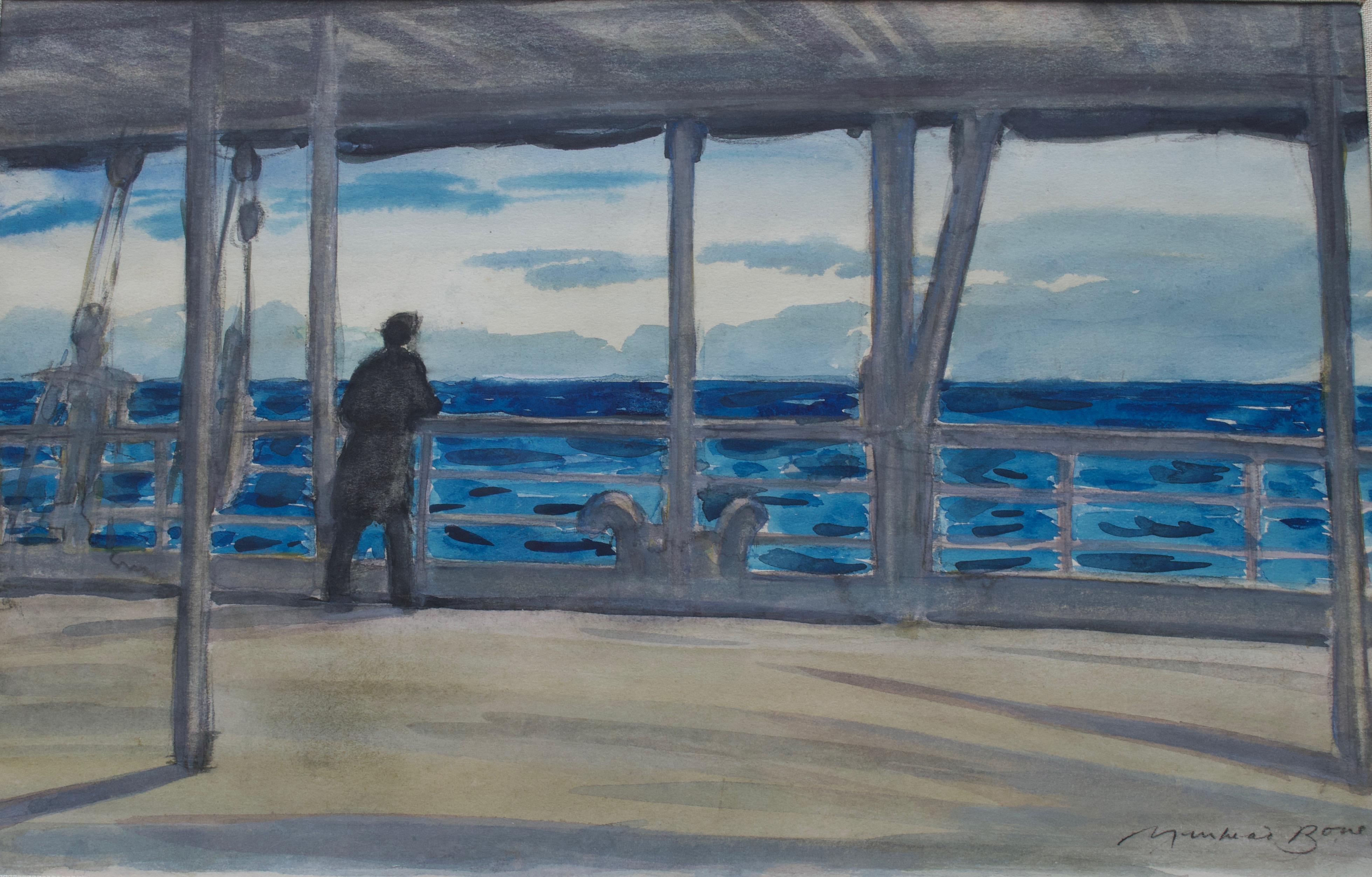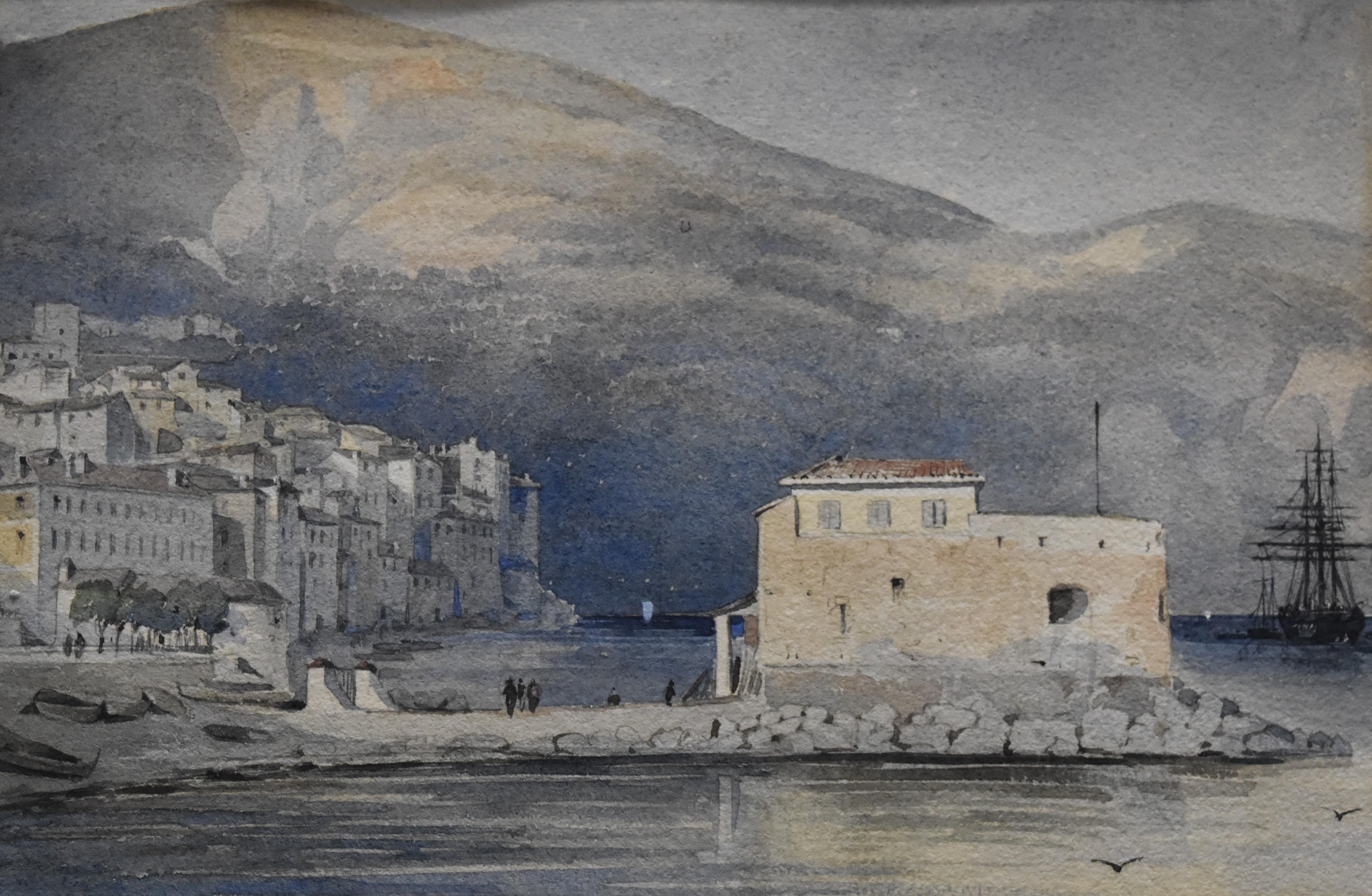Items Similar to James Ward The Fisherman's Family
Want more images or videos?
Request additional images or videos from the seller
1 of 10
James WardJames Ward The Fisherman's Family1830-1840
1830-1840
About the Item
Precious Watercolor attributed to James WARD (1769-1859) - England, 1830-1840. The Fisherman' S Family. Measurements : View : 20"x14.6" (51x37 cm), With frame : 26.6"x21.5" (67.5x54.5 cm). The frame is gilded with gold leaves. Unsigned. Purchased in 1959 in a public auction by a President magistrate of Brussels. this watercolor has been recognized as from James Ward by the famous Fievez Gallery (auction house), rue du Grand Cerf, Brussels, Belgium, in 1959.
Exposed to the sun, the paper was stuck on another sheet of paper due to very small "moth holes" and a small lack of paper (near the bottom of the roof on the left, see arrow). Some scratches.
Born in London, and younger brother of William Ward the engraver, James Ward was influenced by many people, but his career is conventionally divided into two periods: until 1803, his single greatest influence was his brother in law George Morland; from that time, it was Rubens. From 1810 or so, Ward started to paint horses within landscapes; slightly later, he turned to very large-scale landscapes, of which Gordale Scar (Tate, London), completed in 1814 or 1815 and depicting Gordale Scar (Yorkshire) as an example of the sublime, is considered his masterpiece and a masterpiece of English Romantic painting.
Ward devoted much of the period 1815-21 to the painting of a gigantic work titled Waterloo Allegory (now lost); this neither was much praised nor brought in the revenue Ward had hoped for. The experience may have embittered him, and the deaths of his first wife and a daughter were among other tragedies. Like many artists of the time, Ward sought commissions from wealthy gentry of their favorite horses, their favorite hunting dogs or their children.
One such family that Ward painted and drew repeatedly, and whom he counted among his friends, were the Levett family of Wychnor Park, Staffordshire. One of Ward's best-known portraits was his Theophilus Levett hunting at Wychnor, Staffordshire of 1817. Another was Ward's 1811 painting entitled The Reverend Thomas Levett and his favourite dogs, cock-shooting. Ward also painted a group portrait of three Levett children — John, Theophilus and Frances Levett. (For the Levetts, see link to the Ward exhibit at the Yale Center for British Art.)
In 1830, Ward moved to Cheshunt (Hertfordshire) with his second wife, but he continued to work, particularly on religious themes. A stroke in 1855 ended his work, and he died in poverty.
James Ward was one of the outstanding artists of the day, his singular style and great skill set him above most of his contemporaries, markedly influencing the growth of British art. Regarded as one of the great animal painters of his time, James produced history paintings, portraits, landscapes and genre. He started off as an engraver, trained by William, who later engraved much of his work. The partnership of William and James Ward produced the best that English art had to offer, their great technical skill and artistry having led to images that reflect the grace and charm of the era. He was admitted for membership into the Royal Academy in 1811.
One of Ward's best-known paintings,The deer stealer, was commissioned in 1823 for the sum of 500 guineas by Ward's patron Theophilus Levett. When the work was finished, Levett pronounced himself delighted with the results, and consequently raised the remuneration to 600 guineas. Subsequently Ward was said to have been offered 1,000 guineas for the painting of 'a nobleman,' which he declined. The painting now hangs at Tate in London.
- Creator:James Ward (1769 - 1859, English)
- Creation Year:1830-1840
- Dimensions:Height: 21.46 in (54.5 cm)Width: 26.58 in (67.5 cm)Depth: 0.6 in (1.5 cm)
- Medium:
- Movement & Style:
- Period:
- Condition:
- Gallery Location:Saint Amans des cots, FR
- Reference Number:1stDibs: LU1088213902362
About the Seller
5.0
Vetted Seller
These experienced sellers undergo a comprehensive evaluation by our team of in-house experts.
1stDibs seller since 2018
34 sales on 1stDibs
- ShippingRetrieving quote...Ships From: Saint Amans des cots, France
- Return PolicyA return for this item may be initiated within 2 days of delivery.
More From This SellerView All
- Henri Rapin, Gouache on Paper "Fructidor", 1924-1928Located in Saint Amans des cots, FRThis gouache is a museal and historical piece. Gouache and charcoal on paper stuck on panel by Henri Rapin, France, 1924-1928. "Fructidor". With frame: 80x114x3 cm - 31.5x44.9x1.2, w...Category
1920s Art Deco Figurative Drawings and Watercolors
MaterialsPaper, Gouache
- "Boating on the Morin River"By André Dunoyer de SegonzacLocated in Saint Amans des cots, FRPen, ink, watercolor and wash on paper by André Dunoyer de Segonzac, France, 1922-1924. Boating on the Morin River. Measurements : with frame: 52.5x65x2 cm - 20.7x25.6x0.8 inches / without frame: 36.5x45 cm - 14.4x17.7 inches. Signed lower left "A. Dunoyer de Segonzac". Colors may vary slightly depending on your screen. The lighter band at the top and the bottom of the piece, visible in the first picture, is only due to the reflection in the protective glass. It does not exist. In its frame gilt with gold leaf and its protective glass. André Dunoyer de Segonzac was born in Boussy-Saint-Antoine (Essonne) July 7, 1884. After his schooling at high school Henri IV, as early as 1900, he attends classes at the National School of Fine Arts in Paris in free listener where he will befriend Charles Dufresne. In 1903, he enters the private studio of Luc-Olivier Merson. In 1907, he studies with Jean-Paul Laurens and attends the La Palette and Colarossi academies in Montparnasse. He meets Luc-Albert Moreau and Jean-Louis Boussingault with whom he shares a studio. His first drawings are published in 1908 in The Great Review and The Witness. Nearly indifferent to contemporary aesthetic revolutions, Dunoyer de Segonzac undertakes, with Jean-Louis Boussingault and Luc-Albert Moreau, to revive Gustave Courbet's realism by performing still lifes, nudes, landscapes, in a thick paste and masonry . In one of his letters to the painter Maurice Boitel, he wrote in the 1950s: "I have not forgotten the heroic period of the independents - when we were grouped around Paul Signac, the charming and valiant Maximilien Luce - in these barracks where the living and authentic Art was grouped outside the academic formulas - or literary and systematic tendencies - which were to lead to this abstract aesthetic of which the painting dies. " In 1908, he begins exhibiting at the Salon d'Automne and the Salon des Indépendants, with Paul Signac and Maximilien Luce. He befriends Apollinaire, Max Jacob, Raoul Dufy and Vlaminck. From this period, renting a house belonging to Signac, Dunoyer discovers the landscapes of Saint-Tropez, to which he will remain faithful and where he lived until the end of his life. He stays in Saint-Tropez only in the summer season. For the rest, he leads a real nomadic life, in search of the motive especially through the Île-de-France, the Grand Morin valley, Feucherolles, Chennevières-sur-Marne, Guyancourt, etc. "I also worked a lot on the banks of the Seine in Chatou, Bougival, Andrésy, Poissy and Triel that I particularly like, with its beautiful Gothic church that is reflected in the Seine and the high wooded hills that surround him", he will say. In 1910, he knows fashion designer Paul Poiret and meets Max Jacob, Raoul Dufy and Vlaminck. From 1910 to 1914, he travels to Italy, Spain, North Africa, and is interested in sport and dance (drawings of Isadora Duncan's Russian Ballets, 1911, The Boxers1910). From 1914 to 1918, mobilized in the infantry, he makes the war hardly, before being assigned to camouflage. He performs many war drawings, valuable for their artistic and documentary value. From 1919, he appears again in many exhibitions, including major Parisian salons. Nearly indifferent to contemporary aesthetic revolutions, Dunoyer de Segonzac undertakes, with Boussingault and Moreau, to revive Courbet's realism by performing still lifes, nudes, landscapes, in a thick and masonry paste. Enlisted in engraving by Jean Émile Laboureur, he makes nearly 1,600 brass plaques from 1919 to 1970. He was president of the Society of French painters-engravers. In 1921, he meets Paul Valéry, Léon-Paul Fargue and Jean Cocteau. In 1928, he makes a trip to America where he met with great success. In 1930, he becomes friend with Derain. In 1933 he receiveds the Carnegie Foundation of Pittsburgh Award and in 1934 the Venice Biennale. During the Occupation, in November 1941, he takes part in a "study trip" to Germany, organized by Arno Breker, accepting, like other artists of the most renowned, to visit the hotspots of German culture as well as artist workshops. After the war, he is exhibited in the best galleries...Category
1920s Realist Figurative Drawings and Watercolors
MaterialsPaper, Ink, Watercolor, Pen
- Berthomme Saint-André, The Nap, Watercolor, 1925By Louis Berthomme Saint-AndreLocated in Saint Amans des cots, FRWatercolor by Louis BERTHOMME SAINT-ANDRE, France, ca.1925. The nap. With frame: 75x60.5 cm - 29.5x23.8 inches, without frame, just the watercolor: 53x39 cm - 20.9x15.35 inches. Signed lower left "Berthomme St André" (see photo). Louis Berthommé Saint-André is a figurative painter, fresco painter, decorator, illustrator, engraver, ceramist and French lithographer born in 1905. He comes from rural and commercial France: his father ran a wine and grocery business. In his youth, Louis Berthommé Saint-André was injured by a kick, which left him with a stiff leg, preventing him from driving, among other things. The family left Oise to settle in Saintes, where the artist studied at La Recouvrance. He entered as a student architect with Georges Naud, responsible for the historical monuments of Charente then, in 1921, he entered the School of Fine Arts in Paris. Louis Berthommé Saint-André is one of the great representatives of French figurative painting in the 20th century. He was trained at the School of Fine Arts by two very old masters who died during his training: Fernand Cormon (1845-1924) and Jean-Paul Laurens (1838-1921). He retains from their training the taste for well-learnt techniques, but from his first works, he is part of modernity. His constructions show decomposed forms inspired by Cézanne, while maintaining a keen sense of rigour. He never strayed from realism, but his very colourful, sometimes incisive palette and his freedom in representation gave his painting a bite and an acidity that placed Louis Berthommé Saint-André among the great talents of his time. Silver medal at the Salon of French Artists where he exhibited from 1924 to 1929, he won the Abd-el-Tif Prise in 1925 and was then the youngest resident of the villa in Algiers. Friend of Jean Launois, in addition to his recognised portraits, he painted Algiers and the Kasbah. His studies of women recall those of Eugène Delacroix, but if his luminous inspiration is due to the Algerian sun, his touch is more Cézanne than purely orientalist. He left Algeria in 1928, to return there in 1931. Before the war, Berthommé Saint-André exhibited regularly in all the major Salons: from 1928 at the Salon d'Automne, at the Salon des Beaux-Arts (1934 to 1936) at the Salon des Tuileries since 1935. His inspiration is close to surrealism . During the Occupation, he became very "fauve", in reaction to the darkness of the war. He joined the Resistance, and collaborated with Vaincre (Resistance newspaper). After the war, he developed a style close to poetic reality (Brianchon, Legueult, Oudot, Terechkovitch, Cavaillès. Caillard, Limouse, and Planson), without however ever being part of the group so called. He is present at the Salon Comparaison, at the Salon of painters Witnesses of our time, is president of the Salon of drawing and water-based painting. He has exhibited solo internationally, in Europe, the USA and Japan in particular. In 1977, he received just before his death, the grand prise of Painters Witnesses of their Time. He died on October 1, 1977 in Paris. Bibliography - Michel Droit. Berthommé Saint-André. Éditions de la revue moderne, 1981 Wall frescoes Entrance to the Direction, National School of Fine Arts, Paris Lycée Charlemagne, Paris, Notre-Dame and the banks of the Seine, 1952 Staircase of the Staff of Poitiers Personal exhibitions Villa Abd-el-Tif, Alger, 1922 Galerie Armand Drouant, Paris, 1928 Galerie Marcel Bernheim...Category
1920s Post-Impressionist Nude Drawings and Watercolors
MaterialsPaper, Watercolor
- Madeleine RENAUD, Watercolor, The Wreath Of CarnationsLocated in Saint Amans des cots, FRWatercolor by Madeleine RENAUD (1900-1994), France. Wreath of Carnations. With frame: 60.2x89 cm - 23.7x35 inches without frame: 73x43 cm - 28.7x16.9 inches. Signed "Madeleine Renaud...Category
20th Century Impressionist Figurative Drawings and Watercolors
MaterialsWatercolor
- Deschmacker, Young Woman Lying By The Sea, WatercolorBy Paul Alex DeschmackerLocated in Saint Amans des cots, FRWatercolor by Paul-Alex Deschmacker, France, 1920s. This watercolor is in the classical period populated by mythological characters of Paul-Alex Deschmacker, itself becoming part of ...Category
1920s Art Deco Figurative Drawings and Watercolors
MaterialsWatercolor
- Berthomme Saint-André, Before Bathing, 1926By Louis Berthomme Saint-AndreLocated in Saint Amans des cots, FRWatercolor by Louis BERTHOMME SAINT-ANDRE, France, 1926. Befor bathing. With frame: 74x63.5 cm - 29.1x25 inches ; without frame, just the watercolor: 50x36 cm - 19.7x14.2 inches. Si...Category
1920s Art Deco Nude Drawings and Watercolors
MaterialsWatercolor
You May Also Like
- Watercolor Interpretation of the The Raft of the Medusa After Théodore GéricaultLocated in Cotignac, FRWatercolour on paper interpretation of the Raft of the Medusa by English artist Derek Carruthers. The work is signed and titled to the back of the paper. A vivid and engaging interp...Category
Late 20th Century Romantic Figurative Drawings and Watercolors
MaterialsWatercolor, Paper
- Follower of Richard Parkes Bonington, A beached vessel on the coastBy Richard Parkes BoningtonLocated in Harkstead, GBA delicately painted view of figures by a beached fishing vessel on the coast Follower of Richard Parkes Bonington, 19th Century Figures on the shore by a beached vessel Watercolour...Category
19th Century Romantic Landscape Drawings and Watercolors
MaterialsPaper, Watercolor
- Sir David Muirhead Bone, A Mediterranean evening on a P & O cruise linerBy Sir Muirhead BoneLocated in Harkstead, GBA wonderfully evocative scene of a passenger looking out to sea on the deck of an ocean liner - from the golden age of cruising. Sir David Muirhead Bone On a P & O, Mediterranean ev...Category
Mid-20th Century Romantic Figurative Drawings and Watercolors
MaterialsPaper, Watercolor
- English School, circa 1800 Georgian watercolor, The Sailor's returnLocated in Harkstead, GBA delightful rustic scene dating to circa 1800 with the sailor returning to his thankful wife and the domestic idyll of his country cottage. The harbour with sailing ships ferrying c...Category
Early 19th Century Romantic Figurative Drawings and Watercolors
MaterialsWatercolor, Laid Paper
- Historical figurative drawing of 19th century Italian RomanticismLocated in Florence, ITThe subject illustrated here is one of the moments that mark the centuries-long history of Genoa's glorious Maritime Republic, when the ashes of St. John the Baptist, one of the city...Category
1860s Romantic Figurative Drawings and Watercolors
MaterialsPaper, Watercolor, Pen, Pencil
- 19th Century french school, Villefranche-sur Mer, the harbour, watercolorLocated in Paris, FRFrench School circa 1850 Villefranche sur mer, the Harbour Watercolor on paper 16 x 24 cm In good condition Framed 29 x 38 cm This very fine wat...Category
1850s Romantic Landscape Drawings and Watercolors
MaterialsWatercolor
Recently Viewed
View AllMore Ways To Browse
Framed Vintage Japanese Paper Painting
Fernando Guerra
Aux Cailles
Watercolor Hamptons
Penley Original
Antonio Rodriguez Morey
Emin Singing Bird
Erich Kruger
Gaston Bogaert
Hermes Atrium
Mark Ruwedel
Mateo Manaure
Milwaukee Braves
Pedro Friedeberg Lithograph
Remington Print Frederick
Rini Dhumal
Ron Russell Paintings
Thomas Hoadly





